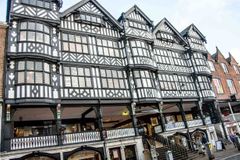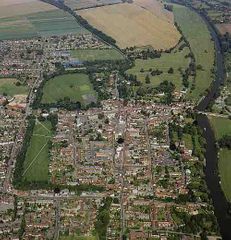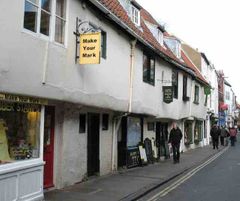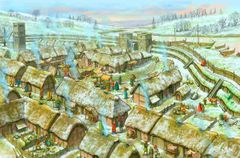![]()
![]()
![]()
Use LEFT and RIGHT arrow keys to navigate between flashcards;
Use UP and DOWN arrow keys to flip the card;
H to show hint;
A reads text to speech;
8 Cards in this Set
- Front
- Back
- 3rd side (hint)
|
Case study of Chester Rows |

• 4 overlapping streets •Roman perimeter with monastic precincts. • 19th century medieval/Tudor frontage. • Undercroft (storage), row (above street), chambers behind/above hall. • Dendrochronology dated 1280-1325. This coincides with a boom in economy during building of Caernarvon Castle and Edward I campaigning. The continuous rows could represent Byzantine imagery. I.e. 38-42 Watergate st. at right-angle, sub-let shop, best evidence from watercolour. |
Streets, Roman, undercroft etc., economy, watergate st. |
|
|
Why were the rows built? |
•Functional •Practical •Commercial •Differential survival? •Passing fashion? |
One-word reasons |
|
|
Case Study: Wallingford burh |

• Growth and shrink from 1250 population to 500 in 1520s. • Open space =/= contraction, possibly used for pasture for pigs. • Defence a facade? •Decayed vs. Reading |
Growth and shrink, contraction doesn’t mean unsuccessful. Competition? |
|
|
Case study of urbanism: Lady Row |

•Lady Row was built in 1316, and is the first terraced construction in England. •10 bays on the edge of a cemetery due to overpopulation, permission granted by a bishop. •Tells us how simple accommodation is hence working class probably lived there, and about overcrowding. |
LR, 1316, terraced, simple |
|
|
What about city walls? |
An emblem of pride, but takes a while to construct. Can exclude others. •Southampton Bargate militaristic entrance and civil guild hall internal view. •Coventry - walls took over a century to build. •London - retains Roman walls due to royal control, most live outside. •Nottingham multiple levels of walls had multiple bibles and cultures. |
Pride, takes time, excludes I.e. SB, C, L, N |
|
|
What are the archaeological challenges of urban excavation/archaeology? |
1. Delays in publishing 2. Erosion of history I.e. medieval Gloucestershire was destroyed largely by development over it. 3. Only cess pits and wells generally survive I.e. York stone well. |
Delays, erosion G, cess pits Y |
|
|
What are examples of urban ‘first floor halls’? (Stone and rectangular). |
Key features: vertical, right-angle, separate functions on different levels. • Stonegate, York •Aaron the Jew’s House •Coventry 2 High st. - undercroft •13 st. Mary hill, Stamford. •Winchelsea - Over 50 undercroft cellars. •Medieval frontage - Salisbury High St. |
Functions, right-angle, Stone gate, Aaron, Coventry, Mary hill, winchelsea, Salisbury. |
|
|
Case Study: Wallingford |

•Anglo-Saxon burh 7-8m deep. •Grew then decayed after taken over by Reading/Oxford resulting in green spaces (kinecroft which revealed a medieval street). •Established 2000pop, by 1520s 500-600pop. •North Gate and St. martins church which had 211 trauma bodies. The castle/priory had pork/game more than others. Pottery had little social difference. Documents show a Jewish quarter adjacent to the castle. |
AS 7-8m, decay, 2000 to 600 in 1520, st martins church, green spaces kinecroft, diet, pottery and Jewish. |

